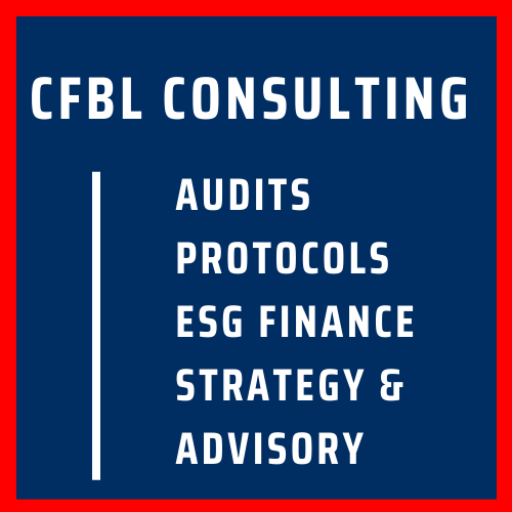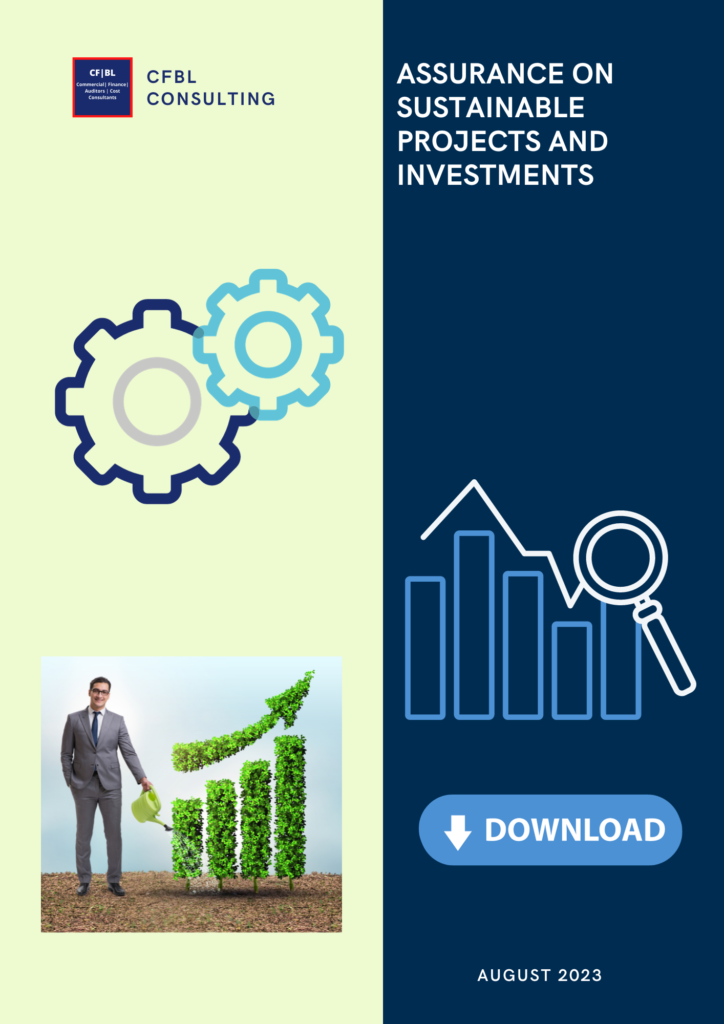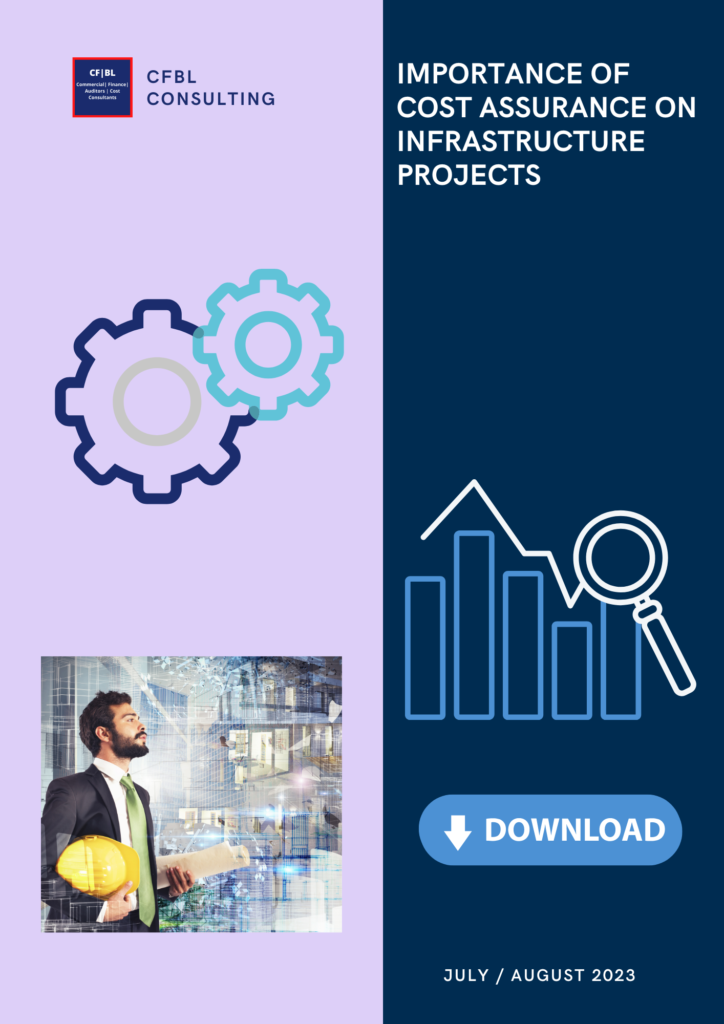
-Cecelia Fadipe (FMCA), CFBL Consulting
The Integral Role of ESG in Contemporary Infrastructure Development

ESG is recognised as a crucial element in modern infrastructure development, with approximately 80% of global greenhouse gas emissions linked to infrastructure.
Overview
This report delves into the incorporation of Environmental, Social, and Governance (ESG) factors in infrastructure investing, shedding light on key considerations and emerging trends. The infrastructure sector, traditionally focused on governance (G), now places increased importance on addressing environmental (E) and social (S) issues as indicators of leading practice.
Striking a Balance Between Economic, Environmental, and Social Considerations
- Achieving a harmonious balance between economic performance, environmental protection, and social responsibility in infrastructure projects is of paramount importance. This involves integrating alternative building materials, recycling concepts, and energy-efficient measures to contribute meaningfully to sustainability objectives.
Benefits for Companies Embracing Sustainability
- Companies adopting a sustainability-oriented approach enjoy several advantages. They generate added value for society and the environment, becoming more appealing to clients, employees, and investors who increasingly prioritise sustainability. The strategic benefits range from risk management to identifying opportunities such as resource efficiency improvements and access to new markets. Compliance with regulations and the avoidance of potential penalties further underscore the profitability of a sustainable business approach.
Significance of ESG Reporting
- ESG reporting holds a central role in a company’s sustainability strategy. It systematically captures, evaluates, and communicates data related to environmental, social, and governance aspects. This transparent representation not only heightens awareness of sustainability issues but also aids in risk management, opportunity identification, and enhances access to financing.
Conclusion
- The integration of ESG considerations into infrastructure projects is not just a moral imperative given the challenges of climate change; it’s a strategic move for companies seeking to enhance their appeal, manage risks effectively, and capitalize on emerging opportunities. The multifaceted benefits of a sustainability-oriented approach position it as the pathway to future profitability and success in the dynamic landscape of infrastructure development.
ESG Key Themes

Embracing ESG factors is not a trend but a necessity for sustainable infrastructure investments! With nearly 90% of institutional investors recognising their significance, it is clear that ESG considerations are shaping the future of infrastructure projects.
Environmental Impact Assessment
- Evaluate and mitigate potential environmental effects, including impacts on ecosystems, air and water quality, and biodiversity.
Sustainable Design and Construction
- Implement green and sustainable construction practices, using environmentally friendly materials and energy-efficient technologies.
Climate Resilience
- Incorporate measures to address and adapt to the potential impacts of climate change, such as extreme weather events, rising sea levels, or temperature fluctuations.
Community Engagement
- Engage with local communities throughout the development process, addressing concerns and ensuring their input in decision-making. This includes considering the cultural and social aspects of the community.
Social Inclusion
- Ensure that the development benefits all segments of the population, with a focus on marginalised or vulnerable groups. Avoid displacement of communities without proper compensation and alternative arrangements.
Health and Safety Standards
- Adhere to stringent health and safety protocols throughout the construction and operational phases, minimising risks to workers and nearby residents.
Resource Efficiency
- Optimize the use of resources during construction and operation, minimising waste and promoting recycling practices.
Biodiversity Conservation
- Implement measures to protect and preserve local biodiversity, including natural habitats and wildlife.
Supply Chain Responsibility
- Ensure responsible sourcing of materials, promoting ethical practices and transparency throughout the supply chain.
Governance and Compliance
- Adhere to regulatory requirements and governance standards, demonstrating transparency and accountability in decision-making processes.
Long-Term Asset Management
- Develop strategies for the long-term management and maintenance of the infrastructure to ensure its ongoing sustainability and functionality.
Community Benefits
- Identify and implement ways in which the infrastructure development can contribute positively to the local community, such as job creation, educational opportunities, or improved access to services.
Navigating ESG in Infrastructure Investments

According to the OECD, embracing sustainable infrastructure investment is pivotal for future economic growth, as emerging markets are geared up to outpace advanced economies by 2040.
ESG has become an increasingly important consideration in the investment cycle of infrastructure projects. Investors are recognising the impact that infrastructure projects can have on the environment, society, and corporate governance, and are incorporating ESG factors into their decision-making processes. Here’s how ESG is integrated into different stages of the investment cycle for infrastructure:
Pre-investment or Due Diligence
- Environmental Considerations: Investors assess the potential environmental impact of the infrastructure project. This includes evaluating how the project aligns with environmental regulations, resource conservation, and sustainable practices.
- Social Impact Assessment: Investors analyse the social consequences of the project, such as its impact on local communities, labor practices, and overall societal well-being.
- Governance Structure: Evaluation of the governance structure of the project and the entities involved to ensure transparency, accountability, and adherence to ethical business practices.
Investment Decision
- ESG Integration: Investors incorporate ESG factors into their overall risk assessment and decision-making process.
- Investments that align with strong ESG principles are often considered more resilient and sustainable in the long term.
- Screening and Ratings: Investors may use ESG screening tools and ratings to identify infrastructure projects that meet their ESG criteria.
Portfolio Management
- Continuous Monitoring: Investors actively monitor the ESG performance of their infrastructure portfolio throughout its lifecycle, ensuring that projects continue to meet ESG standards.
- Engagement and Collaboration: Investors engage with project managers, developers, and other stakeholders to address and improve ESG performance over time.
Exit Strategy
- ESG Reporting: As part of the exit strategy, investors may require comprehensive ESG reporting from the infrastructure projects to demonstrate their commitment to sustainable and responsible practices.
- Impact Measurement: Investors assess the overall impact of the infrastructure project, not only in financial terms but also in terms of its positive or negative contributions to environmental and social aspects.
Post-investment Monitoring
- Adaptation to Changing ESG Landscape: Investors stay adaptable to changes in ESG regulations and standards, ensuring that their infrastructure investments remain compliant and responsive to evolving sustainability expectations.
Current Challenges Surrounding ESG

ESG reporting is a central component of a company’s sustainability strategy. It enables transparent portrayal of sustainability performance and provides important information for internal and external stakeholders. – Robert Kammerer,Partner at PwC Germany
Challenges in ESG Evaluation
- Reliance on non-statutory public disclosures lacking standardised formats and external audits.
- Absence of regulatory requirements leading to potential incomplete or inconsistent information.
Consensus and Consistency Issues
- Lack of agreement and consistency in measuring and valuing ESG performance.
- Companies prioritise different ESG factors, hindering the establishment of a universal benchmark.
Financial Impact Measurement Variability
- Some ESG factors have easily measurable impacts (e.g., energy and water efficiency improvements).
- Others, such as enhanced employee well-being or long-term community benefits, require more in-depth analysis.
Integration into Company Valuation
- Financial impact of ESG factors may not be consistently integrated into a company’s overall valuation.
- Varies across companies, indicating a lack of uniformity in how ESG considerations influence financial assessments.
Infrastructure Funds’ Customised Approaches
- Recognition of the specificity of ESG impacts on different businesses.
- Development of bespoke frameworks for ESG evaluation by infrastructure funds.
Use of External Provider Scores
- Some funds use external provider scores as a reference.
- Emphasis on understanding the unique drivers and impacts of ESG initiatives rather than solely relying on numerical scores.
Company-Specific Impact of ESG Factors
- Impact is often highly company-specific, dependent on actions taken, assets operated, and unique circumstances.
- External scoring systems may not capture these nuanced details accurately.
Need for Nuanced, Customised Approach
- Challenges underscore the importance of a nuanced, customised approach for ESG evaluation.
- Emphasis on moving beyond numerical scores to understand the real-world impact of ESG initiatives.
The reliance on non-statutory disclosures, lack of consensus in valuation methods, and variability in financial impact measurement contribute to the complexity. Infrastructure funds, recognising the specificity of ESG impacts, employ bespoke approaches. External scores are considered but are secondary to understanding underlying drivers. Overall, there is a need for a nuanced, customised approach that goes beyond numerical scores to comprehend the real-world impact of ESG initiatives.
Potential Opportunities In ESG 1

86% of employees prefer to support or work for companies that care about the same issues they do.
ESG Trends in Infrastructure
- Climate change, supply chain, and corporate purpose are three key ESG trends affecting the infrastructure sector.
- These trends bring both risks and opportunities to the sector due to the essential nature of its services.
Climate Change as a Major Concern
- Climate change is the most significant ESG concern in the infrastructure sector.
- It is viewed as a structural, long-term crisis with potential significant impacts.
Physical Risks of Climate Change
- Infrastructure faces increased physical risks, such as droughts affecting water companies, storms impacting the solar energy sector, and rising sea levels affecting coastal assets globally.
- Asset managers are required to closely monitor assets, work with portfolio companies on resilience plans, and assess financial impacts of climate risks.
Transition Risks and Long-Term Value
- Asset managers aim to protect the long-term value and operability of assets amid the energy transition and policies for achieving net zero by 2050.
- Transition risks require strategic planning to navigate changes in the energy landscape.
ESG Measures and Associated Costs
- ESG measures are typically linked to initial investments in infrastructure.
- Covering increased operating expenses may involve grants, tax funding, or raising fees and prices, posing a challenge in balancing ESG standards with associated costs.
Preparation for Capital Reallocation
- Companies, investors, and governments are urged to prepare for a significant reallocation of capital due to the impact of climate change.
- Strategic planning is essential to adapt to the changing landscape and remain resilient in the face of ESG challenges.
The field of Environmental, Social, and Governance (ESG) presents numerous opportunities across various sectors. Here are some potential opportunities in ESG:
Green Finance and Investing
- There’s a growing demand for sustainable and responsible investment opportunities. ESG considerations are becoming a crucial factor for investors looking for long-term, ethical investments.
- Opportunities exist in developing and managing green bonds, sustainable investment funds, and other financial instruments that align with ESG principles.
Renewable Energy
- The push for clean energy and the transition away from fossil fuels creates opportunities in renewable energy projects such as solar, wind, and hydroelectric power.
- Jobs in research and development for innovative energy solutions also contribute to ESG goals.
Potential Opportunities in ESG 2

7 % of the Utilities Sector”s Environmental Impact is located within the supply chain.
Sustainable Agriculture
- Sustainable and regenerative agriculture practices are gaining traction. Opportunities exist in developing and promoting technologies and practices that reduce environmental impact while ensuring food security.
Social Impact Investing
- Investments in projects that have a positive social impact, such as affordable housing, education, and healthcare, are becoming more prevalent.
- Social impact bonds and other financial instruments that link returns to measurable social outcomes are gaining popularity.
ESG Consulting and Advisory
- Companies are increasingly seeking guidance on incorporating ESG principles into their business strategies. Consulting firms specialising in ESG can help businesses navigate this landscape.
Corporate Governance Services
- As companies prioritise better governance, there are opportunities for providing services related to corporate governance, board diversity, and ethical decision-making.
ESG Data and Analytics
- With the need for transparent and reliable ESG reporting, there’s a demand for companies specializing in collecting, analysing, and providing ESG data.
Green Technology and Innovation
- Develop and invest in technologies that contribute to environmental sustainability, such as energy-efficient solutions, waste reduction technologies, and eco-friendly products.
ESG Ratings and Certification
- With the increasing importance of ESG performance, there are opportunities for companies that provide ESG ratings, certifications, and audits.
Education and Training
- There’s a growing need for education and training programs related to ESG principles and practices. This includes training for professionals, corporate executives, and investors.
Circular Economy
- Opportunities exist in developing and promoting circular economy models, where products are designed to be reused, recycled, or repurposed, reducing overall environmental impact.
These opportunities reflect the broad spectrum of possibilities within the ESG space, encompassing finance, technology, consulting, and various industries working towards sustainability and social responsibility.
Climate Resilience in Infrastructure

80% of investors recognise the value of integrating ESG into infrastructure developments and aligning long-term goals with ESG principles
Definition of Climate-Resilient Infrastructure
- Infrastructure planned, designed, built, and operated anticipating, preparing for, and adapting to changing climate conditions.
- Capable of withstanding, responding to, and recovering rapidly from disruptions caused by climate conditions.
- A continual process throughout the life of the asset.
Interaction of Climate Hazards, Exposure, and Vulnerability
- Climate risks to infrastructure depend on the interaction of changing climate hazards with exposure (location of assets) and vulnerability (propensity to be adversely affected).
- Strategies to reduce risks include locating assets in less exposed areas and enhancing assets’ ability to cope with climate impacts.
Risk Management and Trade-Offs
- Risk management involves trade-offs between risk minimisation and cost.
- Resilience means managing risks to achieve an acceptable level of performance, considering capacities to withstand and recover from shocks.
Cost-Benefit Analysis for Protective Infrastructure
- Costs of protection (e.g., flood defenses) weighed against the consequences of damage or disruption to the asset.
Systemic View on Climate Resilience
- Climate resilience of individual assets should be viewed in the context of the entire infrastructure system.
- A strategic approach to infrastructure network planning is essential, accounting for direct and indirect effects of climate change.
Categories of Adaptation Measures
Structural Adaptation Measures
- Examples include changing road surface composition to withstand high temperatures, building seawalls, and using permeable paving surfaces.
- Ecosystem-based approaches using natural infrastructure.
Management (Non-Structural) Adaptation Measures
- Examples include adjusting maintenance timing for changing energy demand, investing in early warning systems, and purchasing insurance.
- Enhanced monitoring of existing assets to reduce the risk of failure as climate conditions change.
- Adaptive management approaches with flexibility to monitor and adjust to changing circumstances over the asset’s lifetime.
Context-Specific Nature of Climate Adaptation
- Measures for achieving climate resilience vary widely depending on the specific context.
- In some cases, no structural changes may be needed, while in others, structural and non-structural measures may be required.
- Overall, the need for a holistic and strategic approach to climate-resilient infrastructure, considering both physical and non-structural measures and adapting to the context-specific challenges posed by climate change.
Outlook and conclusion

Over 70% of nations are required by two international agreements to attain net-zero emissions by 2050
Outlook:
Growing Emphasis on ESG Integration
- The outlook for ESG integration in infrastructure development remains positive, with a continued global emphasis on sustainable and responsible business practices. Investors, governments, and stakeholders increasingly recognise the long-term benefits of incorporating environmental, social, and governance (ESG) considerations into infrastructure projects.
Regulatory Frameworks
- Anticipate the development of more robust regulatory frameworks that encourage or mandate ESG integration in infrastructure development. Governments worldwide are likely to adopt and strengthen policies to promote sustainable practices, ensuring that infrastructure projects align with broader environmental and social goals.
Innovation and Technology
- The integration of ESG principles will drive innovation and the adoption of new technologies in infrastructure projects. From renewable energy solutions to smart city initiatives, advancements in technology will play a pivotal role in achieving sustainable and resilient infrastructure development.
Investor Preferences
- Investors are expected to increasingly favor projects with strong ESG credentials. Financial institutions, including private equity firms and pension funds, are likely to prioritise investments that demonstrate a commitment to sustainability, thereby influencing the project funding landscape.
Community Engagement
- Expect a heightened focus on community engagement and stakeholder consultation in infrastructure development. Projects that actively involve and address the concerns of local communities are likely to garner more support and face fewer obstacles, contributing to smoother project implementation.
Conclusion
- The integration of ESG factors in infrastructure development is not just a trend but a fundamental shift towards responsible and sustainable business practices. As the world faces unprecedented challenges related to climate change, social inequality, and governance issues, infrastructure projects play a crucial role in shaping a more sustainable and resilient future.
- In conclusion, ESG integration in infrastructure development is not only a moral imperative but also makes good business sense. Companies and governments that proactively address environmental impacts, social considerations, and governance issues will be better positioned to navigate the evolving global landscape.
- The long-term success and viability of infrastructure projects hinge on their ability to align with the principles of sustainability, meet the expectations of diverse stakeholders, and contribute positively to the well-being of both the environment and society. As the ESG landscape continues to evolve, those who embrace these principles will likely find themselves better equipped to thrive in an increasingly conscientious and interconnected world.
Frequently Asked Questions

According to the OECD, embracing sustainable infrastructure investment is pivotal for future economic growth, as emerging markets are geared up to outpace advanced economies by 2040.
1. How can businesses adapt their pricing strategies during inflationary periods?
A. Businesses can consider dynamic pricing models that allow for flexible adjustments based on cost fluctuations. This approach helps maintain competitiveness without compromising profitability.
2. What steps can be taken to mitigate the impact of rising supply chain costs?
A: Diversifying suppliers, optimising logistics, and renegotiating contracts can help manage increased supply chain costs. Seeking alternative sourcing options also reduces dependency on vulnerable supply routes.
3. How does agile decision-making support businesses during inflation?
A. Agile decision-making enables swift responses to market changes, allowing businesses to adjust strategies, pricing, and resource allocations in real-time to mitigate inflationary impacts.
4. What role does innovation play in combating inflationary pressures?
A: Innovation fosters value creation and differentiation. Businesses innovating in product offerings or processes can offset rising costs, maintaining competitiveness.
5. How crucial is customer-centricity during inflationary periods?
A: Understanding changing customer needs is pivotal. Businesses that tailor offerings and services effectively to evolving customer preferences can maintain loyalty and mitigate the impact of inflation on consumer spending.
6. What financial strategies can businesses employ to navigate inflation?
A: Smart financial planning involves managing cash flows efficiently, diversifying investments, and exploring hedging options to safeguard against inflation’s financial impacts.
7. Why is resilience important in inflationary times, and how can it be fostered?
A. Resilience ensures adaptability. Businesses resilient to inflationary pressures focus on diversification, optimisation, and continuous improvement across operations, enabling them to weather uncertainties effectively.
8. What is ESG integration in the context of infrastructure development?
A: ESG integration refers to the incorporation of environmental, social, and governance factors into the planning, design, construction, and operation of infrastructure projects. It aims to ensure sustainable and responsible practices throughout the project lifecycle.
9.Why is ESG integration important in infrastructure development?
A: ESG integration is crucial as it helps mitigate environmental impacts, ensures social inclusivity, and promotes good governance. It enhances long-term value, minimises risks, and aligns projects with global sustainability goals.
10. How can ESG factors be incorporated into the infrastructure planning phase?
A. During planning, consider environmental impact assessments, community engagement, and governance structures. Identify and assess potential risks and opportunities related to ESG factors to inform decision-making.
References
- An interview with PwC expert Robert Kammerer, talking about the role of ESG in modern infrastructure projects.
- ESG incorporation in infrastructure – what best practice looks like
- Green Infrastructure in Construction Promoting Environmental Benefits – Utilities One
- Statista – Share of professional investors increasing their ESG investments worldwide 2023
- PWC Beyond compliance: Consumers and employees want business to do more on ESG
- Linklaters – ESG
- oecd-ilibrary.org – ESG and institutional investment in infrastructure
- Oliver Wyman/ WWF – Incorporating sustainability into infrastructure
- Environment, social and governance research of infrastructure investment: A literature review Author links open overlay panelXia Qi, Bowen Wang, Qun Gao
- OECD – Climate resilient infrastructure
- Climate Portal – Climate resilient infrastructure
- GiHub – A strong enabling environment can integrate ESG into infrastructure investments



